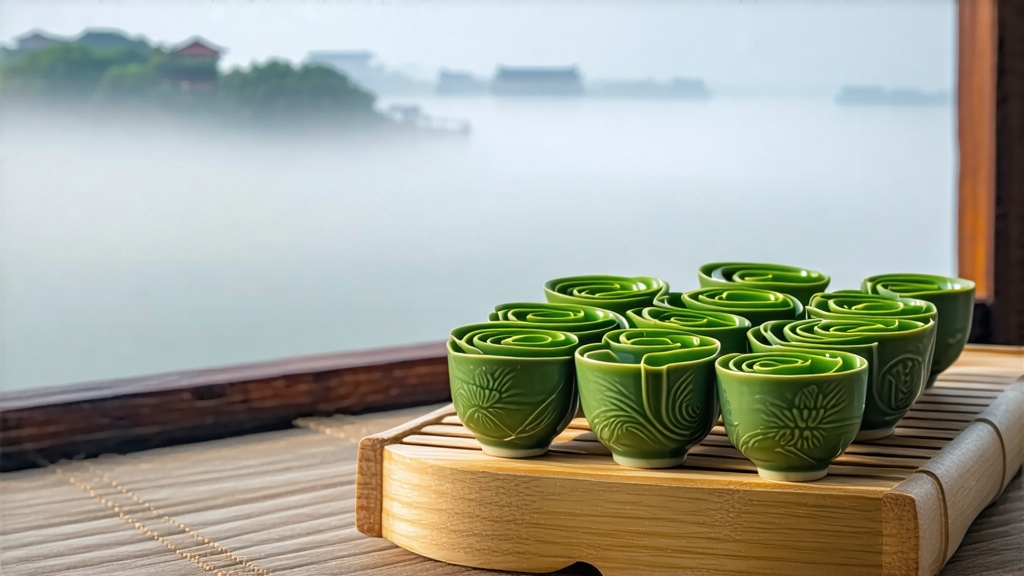
Among the pantheon of Chinese green teas, none carries the romance of lake mist and imperial whim quite like Biluochun. Its name, literally “Green Snail Spring,” hints at the tea’s appearance—tight, spiral-shaped pellets that resemble tiny jade snails—and at the season when the first downy buds are plucked just as the hills of Jiangsu awaken from winter dormancy. International drinkers often meet it under the older romanization “Pi Lo Chun,” yet whatever the spelling, the leaf tells the same story: a fragile green coil that unfurls in hot water to release an almost improbable bouquet of orchid, peach and alpine air.
Origin myths cluster around Lake Tai, the vast freshwater expanse west of Shanghai. The most quoted tale dates to the Kangxi era (1662-1722) when the emperor, touring the scenic Dongting Peninsula, was offered an unnamed local tea whose haunting fragrance drifted ahead of the cup. Enchanted, he christened it “Green Snail Spring” for its shape and harvest time. Whether apocryphal or not, the story secured imperial favor; within decades the tea displaced Longjing at court and entered the canonical list of “China’s Ten Famous Teas,” where it remains today.
Geography is the first secret. The Dongting range is actually two islands—East and West Dongting—thrust up in the lake’s center. Peaches, plums and loquats grow between the tea bushes, their roots interlacing, their blossoms sharing pollinators. The fruit trees act as windbreaks and scent donors; when the dew evaporates at sunrise it carries microscopic oils from petals to tea leaves, accounting for the tea’s signature fruity top note. Soils are acidic, well-drained quartz sands laced with shell-rich loam deposited by ancient lakebeds, giving the leaf a natural umami sweetness that chemists trace to unusually high levels of theanine and dimethyl sulfide.
Plucking is ruthless in its selectivity. Only the bud and the immediately adjacent half-expanded leaf are taken, and only between the Qingming festival (early April) and the spring equinox. A skilled picker gathers barely 500 grams of fresh leaf in a day’s work; it takes 55,000 buds to yield one liang (50 g) of finished Biluochun. The leaf must reach the village workshop within two hours, before enzymatic oxidation edges past the green threshold.
Withering is brief: the baskets rest in shade for thirty minutes, just long enough for surface moisture to evaporate and for grassy volatiles to dissipate. What follows is a masterclass in micro-fire control unique to Biluochun. Craftspeople call it qing-guo, or “green-fruit wok work.” A cast-iron pan is heated to 180 °C, then cooled to 80 °C within seconds by swirling in cool lake water. The leaves—no more than 250 g at a time—are tossed against the scorching metal, their moisture content dropping from 75 % to 45 % in under four minutes. Fingers press, roll and flick the mass in a motion that mimics the spiral of a snail shell. The temperature curve is repeated three times, each cycle lowering both heat and leaf weight until the moisture hovers at 20 %. Finally the leaf is shaped: palms rub the warm bundle along the wok’s rim, coaxing it into the tight spiral that will lock in fragrance. When the pellets hiss and bounce like tiny marbles, the tea is done. Total processing time: forty minutes from leaf to snail.
The dry leaf is deceptive—dull green dusted with silver, almost too modest to promise greatness. Place three grams in a tall glass, add 80 °C water, and watch the show. The spirals sink, then slowly unwind like green silk ribbons. Within thirty seconds the liquor turns pale champagne; within a minute an aroma cloud rises that sommeliers struggle to label: white peach skin, freesia, a trace of pine sap. On the palate the tea is feather-light yet densely layered. The first infusion delivers a bright snap of malic acidity reminiscent of green apple; the second brings a custardy sweetness and a mineral finish that echoes wet granite; the third lingers with a cooling menthol note that invites another sip. Professional cuppers score Biluochun on three metrics rarely applied together to other greens: “spiral integrity” (the pellet must survive brewing intact), “